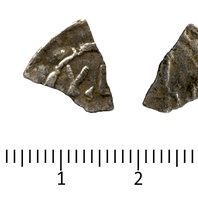
Viking Objects
Arabic Silver Dirham Fragment (SWYOR-1AE8AA)
This silver dirham fragment does not provide enough information to determine the ruler or moneyer but it seems to be from the seventh to ninth century. The dirham was a unit of weight used across North Africa, the Middle East, and Persia, with varying values which also referred to the type of coins used in the Middle East during the Viking Age. These coins were extremely prized possessions not only for their silver value but as a way of displaying one’s wealth and vast trade connections. Millions of Arabic dirhams would have been imported throughout the Viking world and are mostly found in hoards.
Read More
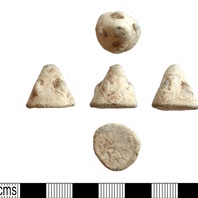
Viking Objects
Lead Gaming Piece (PUBLIC-67DBE3)
This and similar pieces have also been interpreted as weights although the gaming-piece interpretation is more secure. Pieces like this would have been used to play hnefatafl and/or Nine Men’s Morris, both of which are known to have been played in Scandinavia in the Viking Age.
Read More
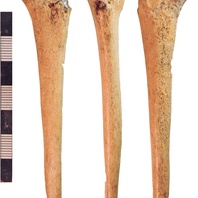
Viking Objects
Pin-Beater (NLM-78D3B5)
This pin-beater was made from a large mammal limb bone, trimmed to a rounded point and smoothed and glossed by wear and handling. Single-ended simple weaving tools are a class linked to the Anglo-Scandinavian use of the vertical loom.
Read More
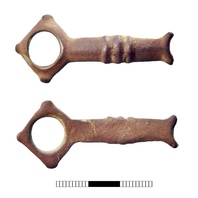
Viking Objects
Harness Fitting (SUR-38C283)
A simple double ended strap-link used as part of a harness. The metal has a reddish tint often associated with Anglo-Scandinavian material.
Read More
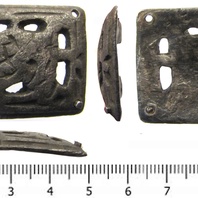
Viking Objects
Anglo-Scandinavian Silver Mount (SWYOR-0201A1)
This silver rectangular mount is decorated with an openwork design consisting of a possible backward-facing animal alongside interlace which may have zoomorphic elements.
Read More
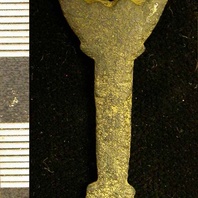
Viking Objects
Copper-Alloy Key (LEIC-931912)
Slide keys such as this example are generally known as ‘Viking keys’ due to similarities in shape with excavated examples. However, its T-shaped projections at the base have no identified parallels but the design could possibly show Anglo-Scandinavian influence. Keys were not only practical items but also symbols of status. Women often carried the keys to the family’s chests of valuables. They also are often buried with keys, representing their authority in the household. See also the blog post on keys in the Viking Age.
Read More
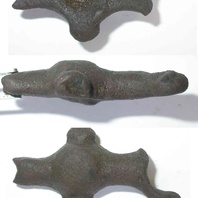
Item
Bridle Fitting (DENO-58B097)
This fragment of cast copper-alloy bridle fitting has a central, sub-circular boss with concave indent to the reverse side. The concave shape of the broken ends of the bars indicate that this fitting originally had a loop at either end.
Read More
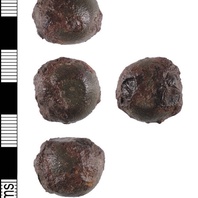
Viking Objects
Globe-Shaped Weight (PUBLIC-D94974)
A globe-shaped copper-alloy weight, with a flat top and bottom each displaying 3 small ring-and-dot motifs. Weights are an important form of evidence for Viking Age commerce and the use of standards across the different economic systems within which Vikings were integrated. Many of the weights discovered, particularly ones in Ireland and those of Arabic type, suggest that a standardized system of weights existed in some areas. These standard weights, alongside standard values of silver, are what allowed the bullion economy of Viking occupied areas to function. A bullion economy was a barter economy that relied on the exchange of set amounts of precious metal in various forms, such as arm-rings or coins, for tradable goods, such as food or textiles. Each merchant would have brought their own set of weights and scales to a transaction to make sure that the trade was conducted fairly.
Read More
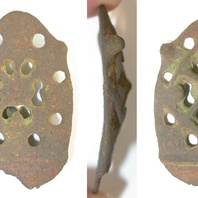
Viking Objects
Copper-Alloy Strap-End (DENO-083C15)
This copper-alloy strap-end, classified as Thomas Class E, is decorated with a central openwork lozenge with two perforations within each quarter surrounded by eight circular perforations. Strap ends came in various styles and were fairly common throughout the Viking world. They were used to decorate the ends of belts and to stop them getting damaged.
Read More
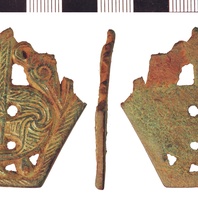
Viking Objects
Copper-Alloy Mount Fragment (NLM-92AFEC)
This copper-alloy mount fragment is likely from a horse harness and is decorated with closely-spaced diagonal hatching framing for a zoomorphic openwork design of four battling beasts around a central roundel. The front of the mount contains extensive traces of gilding. The object is considered an example of Irish or Hiberno-Norse metalwork and thus is associated with Viking activities around the Irish Sea region.
